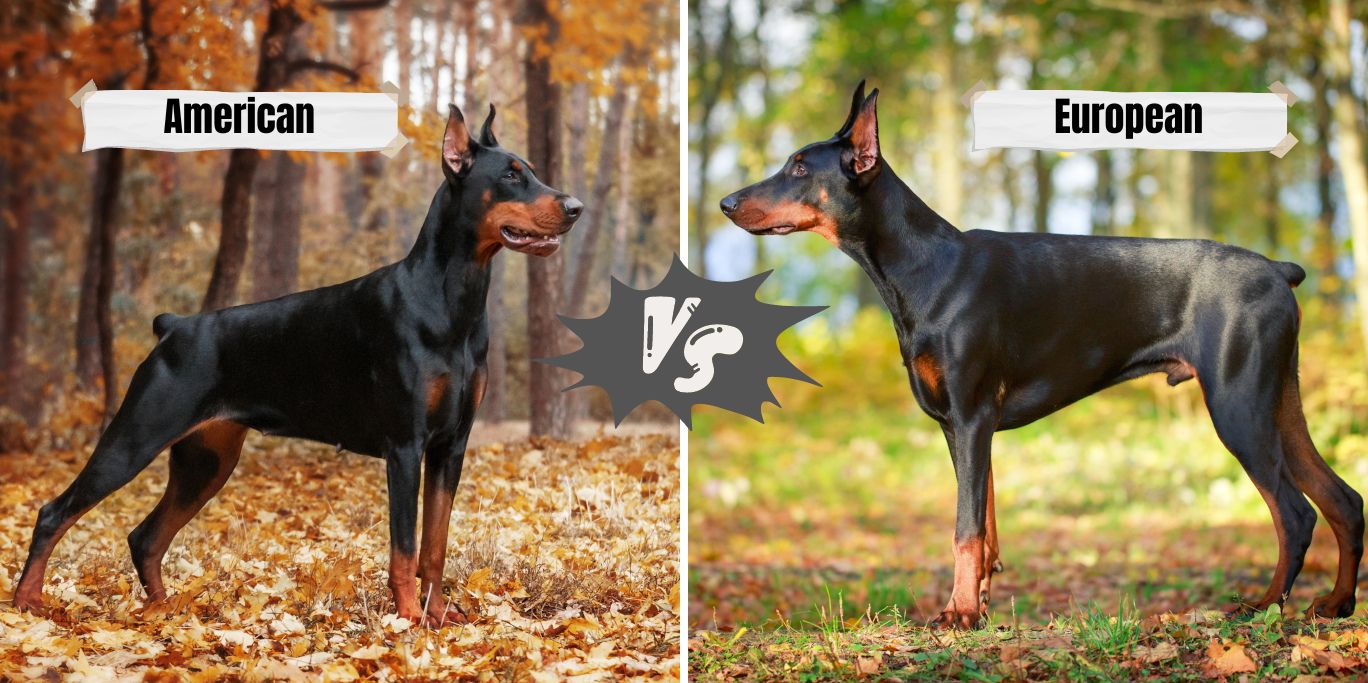
The Doberman Pinscher, a dog breed revered for its intelligence, loyalty, and majestic appearance, stands as a symbol of protection in households worldwide.
Yet, even within this singular breed, there lies a divergence that many are unaware of: the distinction between the American and European Doberman Pinscher. Each variant, while sharing the iconic Doberman lineage, possesses unique attributes that set them apart in more ways than mere geography suggests.
As we venture into this exploration, we’ll uncover the myriad differences—some subtle, some pronounced—that define these two remarkable sub-breeds.
Whether you’re a potential Doberman owner or simply a canine enthusiast, the revelations ahead promise to be both enlightening and engaging, with tables included to illustrate the more tangible differences between the two.
American Doberman vs. European Doberman: Origins and History
In the heart of Germany, during the late 19th century, the Doberman Pinscher breed was born.
Named after the tax collector Louis Dobermann, the breed was initially developed to serve as a loyal guard dog, accompanying its namesake on his potentially dangerous rounds.
Louis sought a dog with a perfect blend of strength, loyalty, intelligence, and ferocity, and through a mix of breeds like the Rottweiler, Black and Tan Terrier, and the German Pinscher, the first Doberman came into existence.
As the breed grew in popularity, it wasn’t long before the Doberman made its way across the Atlantic to America. The journey overseas initiated a natural evolution in breed characteristics due to varying breeding priorities and regional needs. Thus, the lineage split, resulting in the American and European variants we recognize today.
In Europe, the emphasis remained on the Doberman’s original role: a working and guard dog. Breeders focused on preserving its strong physique and acute protective instincts. The American breeders, in contrast, leaned towards a more refined look suitable for dog show standards without compromising the breed’s intelligence and loyalty.
Over the decades, these priorities sculpted two Doberman types with distinguishable physical and temperamental traits. While they share a common ancestral legacy, the journey of the American and European Doberman diverged, crafting the unique identities we aim to delve into.
Physical Differences
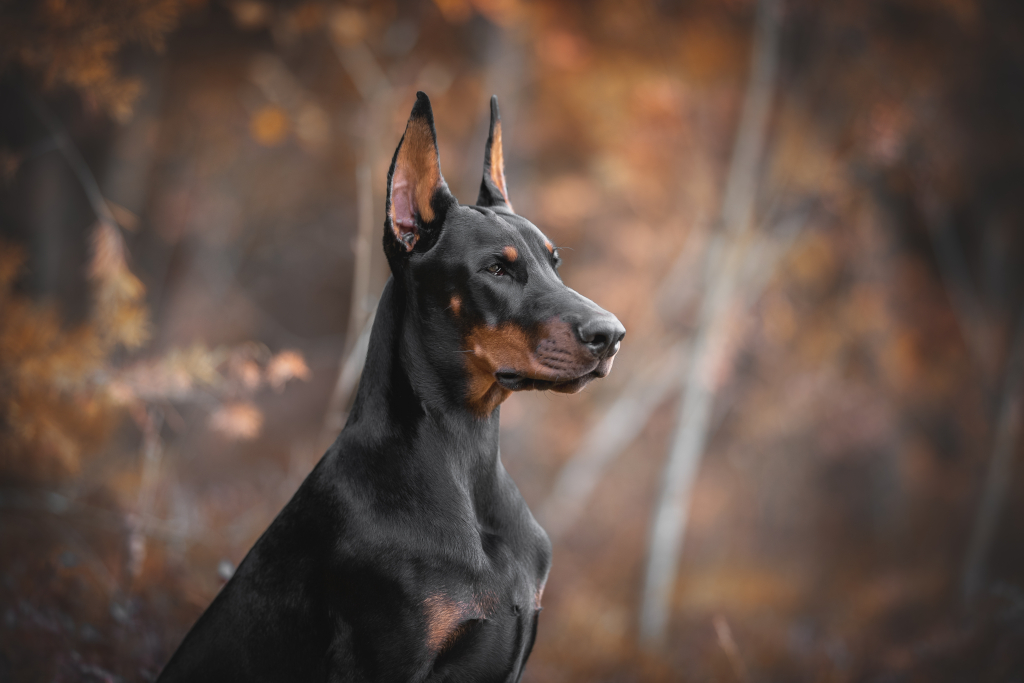
The allure of the Doberman Pinscher lies not just in its temperament but also in its sleek, powerful appearance. But a closer inspection reveals intriguing differences between the American and European variants.
Let’s dissect these physical distinctions to better understand what sets them apart.
1. Size and Build
Generally, the European Doberman boasts a more robust build, with males weighing between 80-105 pounds and standing at 27-28 inches tall. Female European Dobermans tend to weigh between 65-85 pounds with a height of 25-27 inches.
On the other hand, the American Doberman Pinscher presents a more refined frame. Males typically weigh 75-100 pounds and measure 26-28 inches in height, while females weigh 60-90 pounds and stand 24-26 inches tall.
The European variety leans more towards a square build, possessing a compact, muscular body, reflecting its working dog heritage. In contrast, the American counterpart showcases a more elongated silhouette, with a slender neck and finer bone structure.
| Feature | American Doberman | European Doberman |
|---|---|---|
| Male Weight | 75-100 lbs | 80-105 lbs |
| Male Height | 26-28 inches | 27-28 inches |
| Female Weight | 60-90 lbs | 65-85 lbs |
| Female Height | 24-26 inches | 25-27 inches |
| Body Structure | Elongated, slender | Compact, muscular, square |
** Comparison Table for Size and Build
2. Coat and Color
A Doberman’s coat speaks volumes about its lineage. The Federation Cynologique Internationale (FCI) breed standard dictates that European Dobermans are bred exclusively in two colors: black or brown, both complemented with rust-red markings.
On the other side of the ocean, the American Kennel Club (AKC) standard permits the Doberman in four distinct colors: black, red, blue, and fawn, all accentuated with rust markings.
It’s also important to note that the intensity of their markings varies, with European Dobermans having a richer, deeper hue.
Additionally, the European Doberman typically sports a thicker coat suited for cooler climates, whereas the American Doberman tends to have a finer, sleeker coat texture.
| Feature | American Doberman | European Doberman |
|---|---|---|
| Permitted Colors | Black, Red, Blue, Fawn (all with rust markings) | Black or Brown (both with rust-red markings) |
| Markings Intensity | Lighter | Deeper |
| Coat Texture | Finer, Sleeker | Thicker |
** Comparison Table for Coat and Color
Temperament and Personality
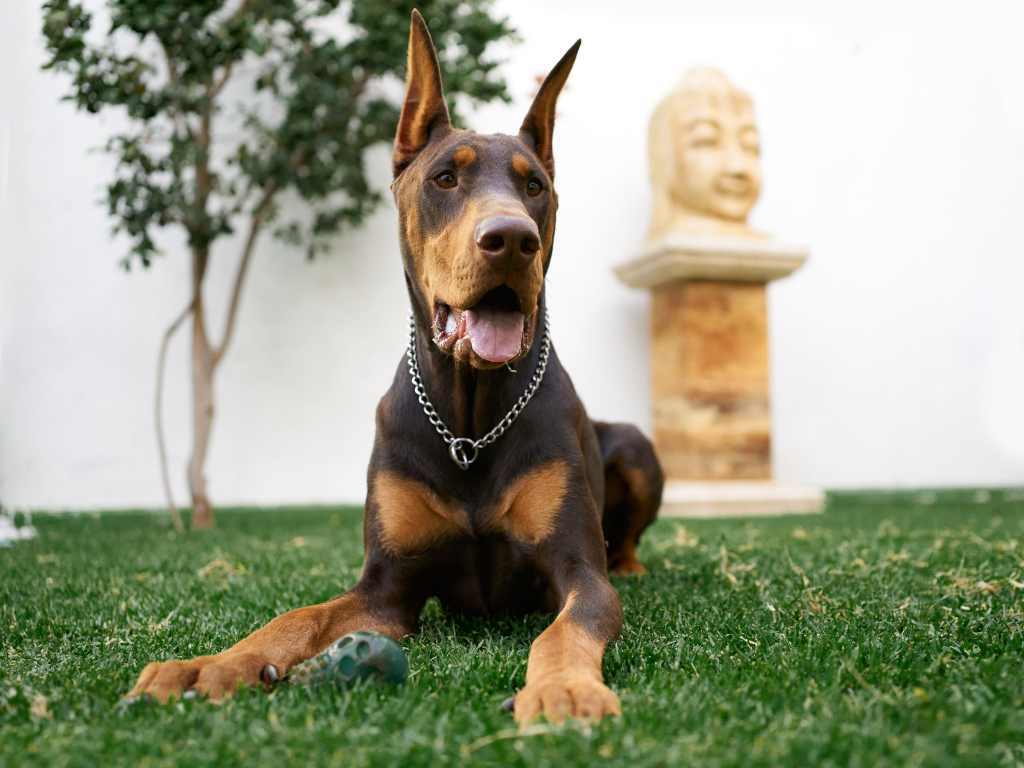
One of the primary attractions of the Doberman Pinscher, irrespective of its origin, is its remarkable temperament. Both the American and European variants are descendants of a lineage designed for protection, but subtle differences have emerged over the years due to selective breeding practices and regional priorities.
- Natural Instincts:
The European Doberman, with its strong working dog heritage, has instincts that are more geared towards protection and guarding. They tend to be more assertive and sometimes even aggressive if they perceive a threat, making them ideal for roles like police or military work.
On the other hand, while American Doberman Pinschers also have protective instincts, years of breeding for show and companionship have mellowed its natural drive, rendering it a bit more adaptable to family settings. - Protective Nature:
Both variants are inherently protective, but the European Doberman is often considered more overtly so. Their quick response and unwavering loyalty make them excellent watchdogs.
The American Doberman, while still protective, is usually more restrained, often assessing the situation before acting. This makes them slightly more approachable, especially in a domestic context.
You May Also Like: Best Guard Dogs to Protect Your Home From Intruders - Alertness Level:
Dobermans, in general, are known for their heightened alertness. However, the European variant’s heightened sensitivity to its surroundings is a touch more pronounced, always on the lookout and ready to spring into action.
The American Doberman, though alert, tends to have a more relaxed demeanor, especially when familiar people are around.
| Feature | American Doberman | European Doberman |
|---|---|---|
| Natural Instincts | Protective but more adaptable to family settings | Strongly geared toward protection |
| Protective Nature | Restrained, assesses before acting | Highly overt and responsive |
| Alertness Level | High, but more relaxed with familiarity | Extremely high and always on guard |
** Comparison Table for Temperament and Behavior
Training and Socialization
The Doberman Pinscher’s intelligence and alertness make it a prime candidate for training, but nuances between the American and European variants can influence the approach and outcome of such training sessions.
- Ease of Training Each Variety:
European Dobermans, with their strong working instincts, often exhibit a high drive and determination. This can make them responsive to training, especially when consistency, firmness, and early initiation are applied. However, their assertiveness might occasionally pose challenges, necessitating an experienced hand.
American Dobermans, having been bred more for show and companionship, often possess a slightly more docile temperament. This can make them a bit easier to train for novice dog owners, as they tend to be more responsive to positive reinforcement techniques. - Social Behavior with Other Animals and Children:
European Dobermans, given their heightened protective instincts, can sometimes be wary of other animals, especially if not socialized from a young age.
It’s crucial to introduce them to various animals and situations early on to ensure balanced behavior. As for children, while they can be protective and caring, supervision is advised due to the dog’s robust nature.
In contrast, American Dobermans tend to be more amiable and tolerant when it comes to other animals and children, thanks to their more companion-oriented breeding.
Proper introductions and early socialization remain essential, but they’re generally more adaptable to diverse household settings.
| Feature | American Doberman | European Doberman |
|---|---|---|
| Ease of Training | More docile, responds well to positive reinforcement | Responsive but may require experienced handling |
| Social Behavior with Animals and Children | Generally amiable, more adaptable to diverse settings | Wary of other animals, protective of children (supervision advised) |
** Comparison Table for Training and Socialization
You May Also Like: 7 Popular Types Of Dog Training: Help Your Pup Becomes A Better Canine Citizen!
Energy Levels and Exercise Needs
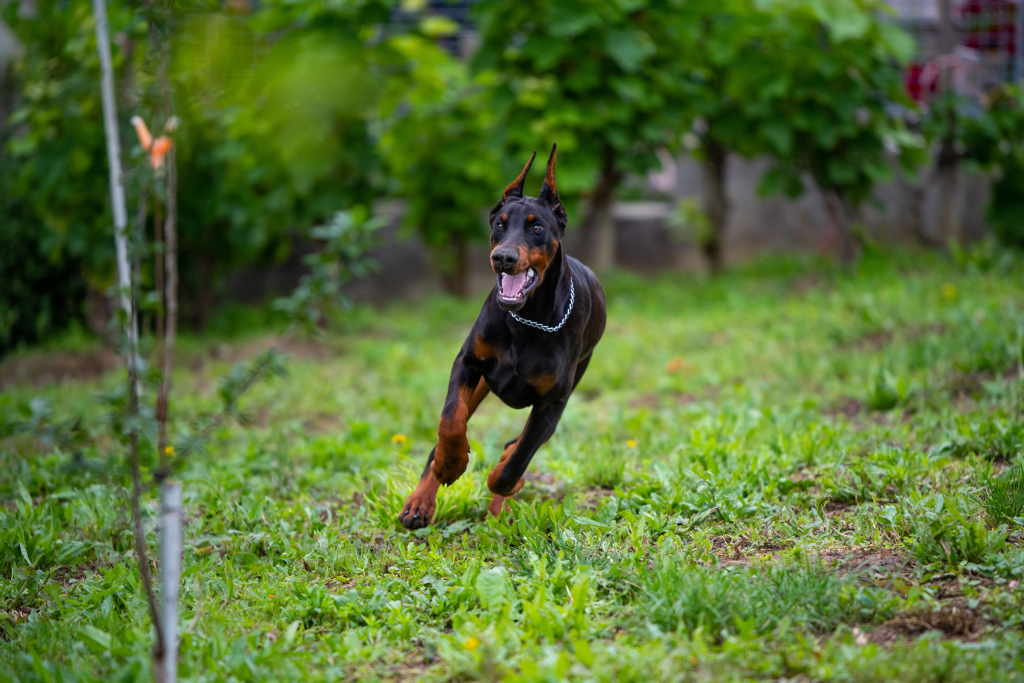
The Doberman Pinscher, regardless of its geographical origin, is a bundle of energy, enthusiasm, and stamina. This breed, known for its athleticism and vigor, requires regular exercise to maintain its health and temperament. However, subtle differences exist between the American and European variants.
- Exercise Requirements:
Originating from a working dog lineage, European Dobermans often have a slightly higher energy threshold.They thrive on intense physical activities, such as agility training, tracking, and even protection work. Daily rigorous exercise sessions, combined with mental stimulation, are paramount to keep them satisfied and prevent undesirable behaviors.
While still energetic, the American Doberman’s exercise requirements are slightly less intense compared to their European counterparts.
They benefit from regular walks, play sessions, and some agility training. Ensuring they receive consistent daily activity is key to keeping them happy and healthy, but it doesn’t always need to be as rigorous as the European variant.
| Feature | American Doberman | European Doberman |
|---|---|---|
| Exercise Requirements | Regular walks, play, and occasional agility work | Intense physical activities and mental stimulation |
** Comparison Table for Energy Levels
You May Also Like: Everything You Need To Know About Hiking With Dogs
Health
Dobies, renowned for their agility and robustness, also carry certain health concerns.
While some health issues are shared between the American and European variants, understanding their specific health tendencies can be instrumental for potential owners and breed enthusiasts.
- Lifespan Comparison:
The American variant typically has a lifespan ranging between 10-12 years, provided they’re given proper care, a balanced diet, and regular health check-ups.
The European counterpart also enjoys a comparable lifespan, generally living between 10-12 years when cared for appropriately. - Common Health Issues in Both Types:
American Dobies are susceptible to conditions like cardiomyopathy, hip dysplasia, von Willebrand’s disease, and progressive retinal atrophy. Regular health screenings can aid in the early detection and management of these conditions.
European Dobermans, while also prone to the ailments mentioned above, this variant might show varying prevalence rates due to different breeding practices and regional genetic pools.
| Feature | American Doberman | European Doberman |
|---|---|---|
| Lifespan | 10-12 years | 10-12 years |
| Common Health Issues | Cardiomyopathy, hip dysplasia, von Willebrand's disease, progressive retinal atrophy | Similar ailments, varying prevalence due to breeding practices |
** Comparison Table for Health
You May Also Like: Why Do Dogs Bite Their Paws?
Nutrition and Diet: European Doberman vs. American Doberman
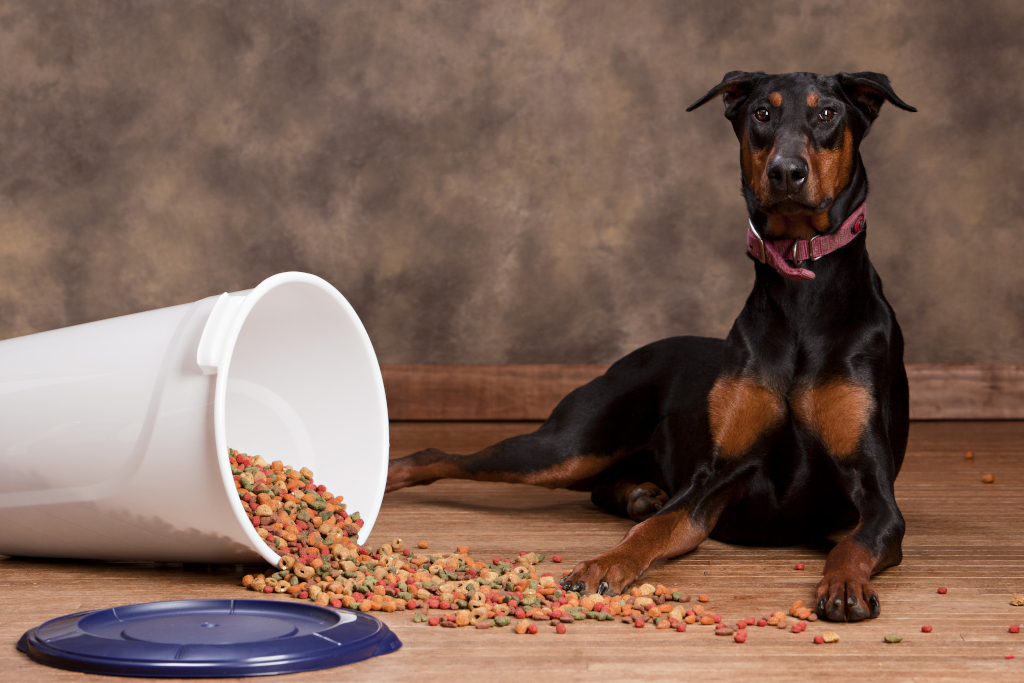
Both the European and American Dobermans have similar nutritional requirements, given that they belong to the same breed. However, like all dogs, the amount of food they need varies based on individual factors.
The perfect diet isn’t solely determined by the variant of Doberman but instead by a combination of individual factors.
It’s essential to provide a balanced diet enriched with proteins, fats, vitamins, and minerals, regardless of the variant. The exact amount they consume daily depends on a myriad of elements, including age, sex, size, and energy levels.
For instance, a European Doberman, known for its slightly larger build and potentially heightened energy levels, might require more sustenance than its American counterpart, especially if the American Doberman leads a more sedentary life.
| Feature | American Doberman | European Doberman |
|---|---|---|
| Basic Nutritional Requirements | Proteins, fats, vitamins, minerals | Proteins, fats, vitamins, minerals |
| Amount of Food (General) | Based on age, sex, size, energy levels | Might eat more due to a larger body and higher energy levels, but still depends on individual factors |
** Comparison Table for Nutritional Needs
You May Also Like: Why Isn’t My Dog Eating?
Grooming Needs
The Doberman Pinscher, irrespective of its regional lineage, is renowned for its sleek and shiny coat. However, there are subtle nuances in grooming needs based on whether it’s an American or European Doberman.
- Specifics for American vs. European Doberman:
Sporting a short, thin coat, the American Doberman is relatively low maintenance in terms of grooming. Regular brushing, around once a week, can help get rid of dead hair and maintain the coat’s natural shine.
They don’t require frequent baths, but occasional sessions can help keep them clean, especially if they’ve been outdoors and gotten dirty.
The European variant, while still maintaining a short coat, tends to have a slightly denser and thicker coat in comparison. This might necessitate a bit more frequent brushing, perhaps twice a week, to ensure the coat remains free from dead hair and retains its luster.
Just like their American counterparts, they don’t require frequent baths unless they have engaged in activities that have made them particularly dirty.
| Feature | American Doberman | European Doberman |
|---|---|---|
| Coat Type | Short, thin coat | Short, slightly denser coat |
| Brushing Frequency | Once a week | Twice a week |
| Bathing Frequency | Occasional, as needed | Occasional, based on activity and dirtiness |
** Comparison Table for Grooming Needs
You May Also Like: 10 Tips to Keep Your Dog’s Paws Healthy
Choosing the Right Fit for Your Home: European Dobie vs. American Dobie
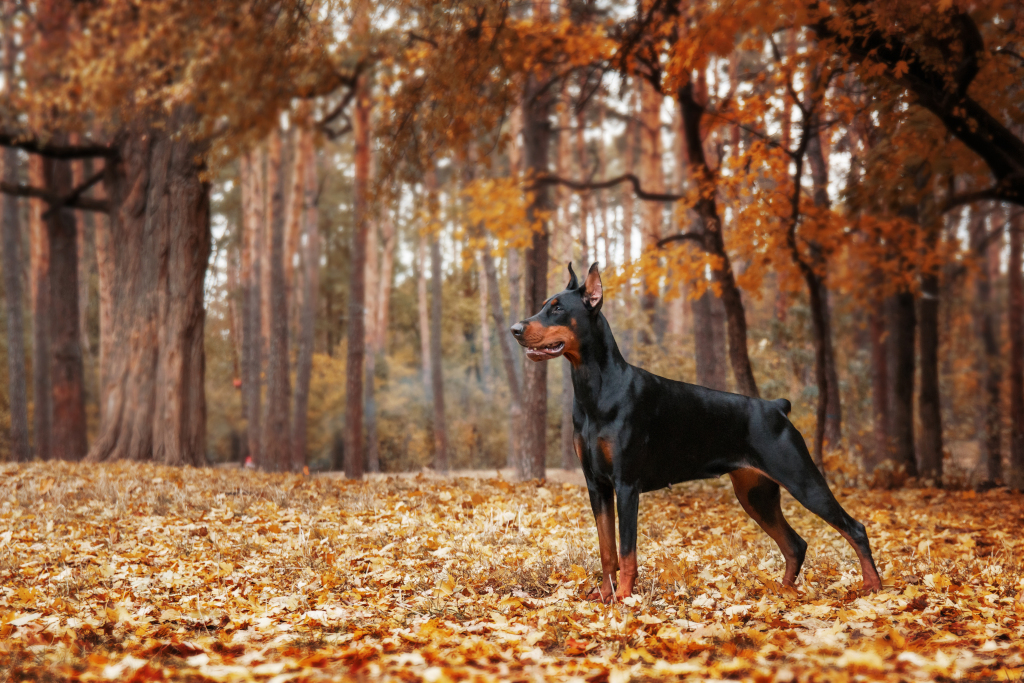
Selecting between an American and a European Doberman goes beyond mere aesthetics or origin preferences. It’s a matter of aligning the dog’s nature, needs, and temperament with your household environment and lifestyle.
- Analyzing Your Living Conditions:
The American Dobe, having been oriented more towards companionship in its breeding, often fits well in urban settings.
Their slightly more docile nature can adapt better to apartment living, though they still need regular exercise. If space is limited, ensuring they have a routine for outdoor activity is vital.
With a more pronounced working lineage, the European Dobie thrives in environments where they have space to move and express their energy. Homes with yards or proximity to parks would be ideal.
Their heightened protective instincts also mean they can be excellent guardians for larger properties. - Lifestyle Considerations:
If your lifestyle is moderately active and leans towards indoor activities, an American Dobe would be a better fit.
While they enjoy outdoor play and walks, they are also content with indoor bonding moments. They might also be more amenable to situations where they are left alone for moderate periods, though they still crave companionship and attention.
For those leading an active lifestyle or for families with a routine that integrates outdoor activities, the European Dobe is a more suitable choice. They relish tasks, training sessions, and intense play, making them great companions for hikes, runs, or agility sessions.
| Feature | American Doberman | European Doberman |
|---|---|---|
| Ideal Living Conditions | Urban settings, apartments (with regular exercise) | Homes with yards, larger properties |
| Alignment with Lifestyle | Moderate activity, more indoor-oriented | Highly active, outdoor-intensive, task-oriented |
** Comparison Table for Choosing the Right Fit
You May Also Like: Biking With Dogs 101: Step-by-Step Guide
How Much Are Dobermans? European vs. American
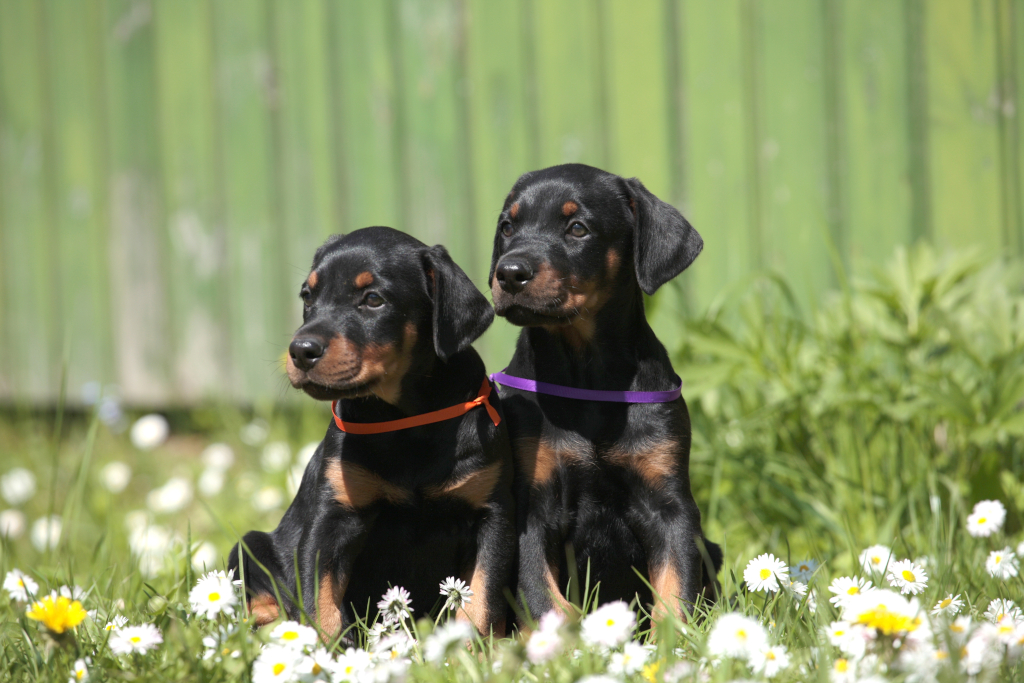
When looking to welcome a Doberman puppy into your home, cost is an essential factor to consider. It’s important to note that the initial price of the puppy is just one aspect, with other costs, including healthcare, grooming, training, and nutrition, to also take into account.
However, when focusing solely on the initial price, one can observe distinct differences between American and European Doberman puppies.
- Puppy Price Differences:
The cost for an American Doberman pup tends to be lower than its European counterpart. Prices can fluctuate based on factors like lineage, breeder reputation, and region, but the average price range for an American Doberman puppy typically falls between $1,500 and $2,500.
The European Doberman puppy, often sought after for their pronounced working lineage and slightly different physical characteristics, commands a higher price. On average, a European Doberman pup can range between $2,500 and $3,500.
| Feature | American Doberman | European Doberman |
|---|---|---|
| Average Puppy Price Range | $1,500 - $2,500 | $2,500 - $3,500 |
** Comparison Table for Puppy Prices
Final Thoughts
Choosing between an American and European Doberman is more than a matter of price or origin; it’s about finding the perfect canine companion that aligns with your home, lifestyle, and personal preferences. Both variants of the Doberman breed bring with them unique traits, histories, and characteristics.
Whether you’re drawn to the American Doberman’s adaptability to urban living or the European variant’s pronounced working lineage and energy, it’s essential to remember that either choice will introduce a loyal, protective, and intelligent member to your family.
Taking the time to understand their specific needs, temperaments, and histories will ensure a harmonious relationship that benefits both the owner and the beloved pet.
European Doberman vs. American Doberman FAQ
Q1. What's the difference between an American Doberman and a European Doberman?
A: At the core, both dog breeds hail from the same ancestry but have evolved slightly differently due to breeding objectives and regional factors. American Dobermans are generally bred more for companionship and have a somewhat sleeker appearance. In contrast, European Dobermans, with a more pronounced working lineage, tend to be slightly more robust and have a denser coat.
Q2. Are European Dobermans stronger than American Dobermans?
A: “Stronger” can be subjective. European Dobermans typically have a sturdier build due to their working lineage, making them physically more robust in some aspects. However, strength can also be gauged in terms of temperament, protective instincts, and resilience, in which both varieties excel in different scenarios.
Q3. What is the best Doberman breed?
A: The term “best” is highly subjective. Both the American and European Doberman varieties have their strengths and suitabilities. The choice should be based on individual preferences, living conditions, and lifestyle needs. What’s crucial is ensuring that the chosen breed aligns well with the owner’s environment and expectations.
Q4. Are American Dobermans good guard dogs?
A: Absolutely. While they have been bred more towards companionship in recent times, American Dobermans still possess the innate protective and alert instincts of their breed. With proper training and socialization, they can be excellent guard dogs, balancing affection towards their family with a wariness of strangers and potential threats.
Q5. Do European Dobermans require more training than American Dobermans?
A: Both varieties benefit significantly from early and consistent training. Given the European Doberman’s working lineage, they might show an eagerness for task-oriented training. However, regardless of the variant, socialization, obedience, and positive reinforcement methods will ensure a well-rounded and well-behaved pet.
Q6. How often should I groom my Doberman, regardless of its type?
A: Both American and European Dobermans have relatively low-maintenance coats. However, European Dobermans might require slightly more frequent brushing due to their denser coat. Regular grooming, including nail trimming and ear cleaning, is essential for both.

